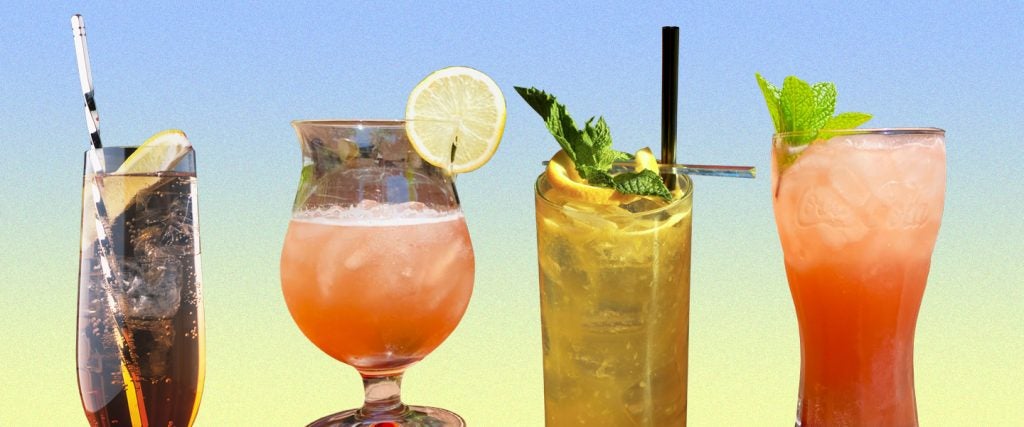The Singapore Sling was born in 1915, in the elegant halls of the Long Bar in Singapore’s beautiful Raffles Hotel. The drink is the brainchild of Ngiam Tong Boon, a veteran barman who whipped up the clever creation in response to requests from women, who were forbidden from drinking alcohol in colonial Singapore.
The solution: A pale, pink-hued drink that looked more like a glass of juice than any cocktail enjoyed by men at the time. Over time, curiosity about the drink bloomed into an outright fandom, with imbibers falling in love with its mix of tart, sweet and earthy tastes. So it is that a combination of gin, cherry brandy, flavored liqueurs and citrus became a signature of Singapore’s finest hotel, drawing the appreciation of fans such as Joseph Conrad and Rudyard Kipling.
Or… did it? Frankly, nobody seems to know. That’s the official story hawked by the Raffles Hotel since the mid-20th century, when the Singapore Sling exploded into the mainstream amid a tiki-drink phenomenon. Hunter S. Thompson honored the cocktail with a mention in his seminal 1971 novel Fear and Loathing in Las Vegas, in which he notes that his squad wasted away afternoons “sitting there in the Polo Lounge — for many hours, drinking Singapore Slings with mescal on the side and beer chasers.” There’s evidence that other bars in Singapore at the turn of the 20th century were refusing to make pink-colored slings, due to the “vulgarity” of mixing so many ingredients.
Yet after all those years, it remains impossible to pin down any kind of “original recipe” for this mythical tropical drink, despite the efforts of booze historians like David Wondrich to investigate its heritage. Even the descendants of Ngiam aren’t sure exactly what to make of the Raffles tale, given they never found an original document and only saw credit being given to Ngiam decades after the supposed invention of the drink.
The claim is that it was invented in 1915, but by Wondrich’s research, this makes little sense: The earliest reference to a sling in Singapore is from 1897, and a newspaper article in 1903 makes a cheeky reference to “pink slings for pale people,” likely a reference to the popularity of the cocktail with white travelers in colonial Singapore. Raffles also claims today that the “original recipe” blends gin, cherry liqueur, curacao, a splash of Benedictine, lime juice, pineapple juice and a touch of grenadine, all shaken with ice and served on the rocks in a tall glass.
But modern bar nerds bicker whether the Singapore Sling should honor its predecessor, the simple Gin Sling, by stripping away the pineapple and grenadine and adding more lime, plus a splash of fizzy soda. Others argue over whether the cherry liqueur needs to be something rich and sweet, like Cherry Heering, or be dry and aromatic, like kirschwasser. Then there’s the matter of actual ratios of each of these intense ingredients — some recipes call for equal parts of gin and Benedictine, while others advocate for a scant quarter-ounce of the funky (but essential) herbal concoction.
So, here’s what we do know for sure: The Singapore Sling is inextricably a result of British colonialism, as a melding of gin, sugar and lime juice — all critical in the history of British maritime dominance and expansionary exploitation — devised by an immigrant Chinese barman working in an Armenian-owned hotel that catered to the (white) colonial bourgeoise. It’s a symbol of the nascent power of globalization, as well as a celebration of human ingenuity and our collective ability to build mythologies about the most mundane things.
Perhaps most of all, the Singapore Sling offers a deliberately shaky framework for cocktail experimentation — a dare, if you will, to try and figure out your own take on this much-debated drink.
For me? I like legendary barman Dale DeGroff’s Raffles version just fine, though I find it a bit sweet and mellow compared to the iteration below. I think erasing pineapple juice (some recipes call for four ounces of the stuff) from the equation altogether is a big bonus in terms of elevating the bitter, floral and mineral notes of orange liqueur, cherry brandy and Benedictine. I still do like the color that a bar spoon of grenadine brings, although you could easily swap that with regular simple syrup or sugar.
An “Authentic” (in Spirit) Take on the Singapore Sling
1 ounce gin
1/2 ounce cherry Heering
1/2 ounce dry orange liqueur
1/4 ounce Benedictine
1 ounce fresh lime juice
1 scant teaspoon of grenadine
Couple dashes of Angostura bitters
Splash of soda water
Combine all the ingredients in a shaker with a handful of ice, then shake vigorously for 15 to 20 seconds. Strain the liquid into a tall glass with fresh ice cubes. Top with a splash of soda water and give it a stir. Popular garnishes include a lime wheel, brandied cherry or pineapple wedge.
Would Ngiam recognize this as his creation? I would hope so, although marketing tactics have a sneaky way of revising the past. I do think, however, that he would find this iteration properly delicious, unlike the slings served in the 1980s with premade sour mix and waterfalls of grenadine.
The Singapore Sling was bastardized for too long — now it’s time to pay respect by sipping a righteous version, just in time for the peak of spring.

